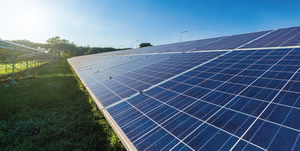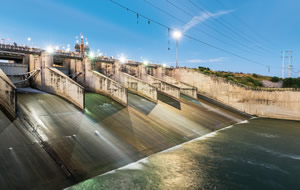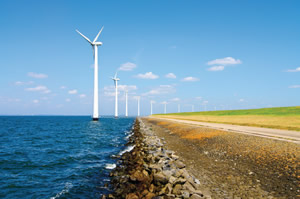Saving Energy: Insights and Ideas

PHOTO © THINNAPOB PROONGSAK
In order to produce
Solar Renewable
Energy Certificates
(SREC s) or Solar
Renewable Energy
Credits, a solar
system must first
be certified by state
regulatory agencies,
usually public
service commissions
or public utility
commissions, and
then registered
with the registry
authorized by the
state to create and
track SRECs.
Colleges and universities tend to be at the
cutting edge of innovation when it comes to energy,
sustainability and general environmental issues
for several reasons: First, their main client base —
the students — demand it. From recent studies,
approximately 66 percent of students claim their
final choice for deciding to attend an institution
relies on that institution’s environmental credibility.
Second, they use copious amounts of resources,
including energy and water. Between athletic
facilities, classrooms, residence halls, dining halls
and lighting and irrigating the grounds, these 24/7
environments, whether large or small, are major
consumers, and their operational choices and
practices have far-reaching environmental affects.
Third, they typically own their buildings, so their
interests in sustainability come from a long-range
view regarding return on investment, because they
would reap the long-term benefits of such investments.
Lastly, while there are several other factors
driving this, higher education institutions’ mission
to educate is perhaps the most important driver for
their interest in environmental stewardship.
Because of these and other drivers, more than
650 colleges since 2007 have joined what is known
as the American College & University Presidents
Climate Commitment (ACUPCC, http://second
nature.org), which requires colleges and universities
to track and report their carbon emissions,
perform two of seven “tangible actions,” and develop
and implement a campus-wide “climate action
plan” (CAP) with the goal of achieving carbon
neutrality by an institute-specified date. These tangible
actions include everything from instituting a
green building policy, which agrees to construct to
meet — at minimum — LEED Silver equivalency;
to establishing a policy for air travel offsets; and
even for the purchase of Renewable Energy Credits
(RECs) equivalent to — at minimum — 15 percent
of an institution’s total electricity consumption.
For reference, one REC equals one Megawatt-hour
(MWh) of electricity into the grid.
A LOOK AT RECS
RECs represent a popular tangible action for
several reasons. First, the process requires simple
tracking of electrical energy use for an entire
campus, which for most institutions is a standard
procedure, even if it can be cumbersome for
larger institutions who may be in a combination of owned and leased buildings. Second, RECs are
good for the environment because they represent a
monetary investment into the national energy grid
at the point where renewables are most desirable
to maximize their output (kWh/dollars invested).
Because renewables are engineering solutions, they
work better in certain contexts, i.e., solar in the Sun
Belt, hydroelectric power in the Pacific Northwest,
or offshore wind for campuses close to a coastline.
In other words, they can be bought independent of
source generation, which also places the competitive
advantage with consumers.

PHOTO © KWANCHAI.C
The federal
Renewable Electricity
Production Tax
Credit (PTC),
established by the
Energy Policy
Act of 1992,
allows owners of
qualified renewable
energy facilities —
hydroelectric and
marine hydrokinetic
(MHK ) (including
wave, tidal, ocean
thermal and
hydrokinetic) — to
receive tax credits
for each kilowatt -
hour (kWh) of
electricity generated
and sold by the
facility.
The money spent on RECs invests that money
where it can do the most good, rather than attempting
to implement renewable projects onsite. RECs
are not attempting to undermine onsite renewable
energy projects as a strategy. What they offer is often
the chance to do more than what can be accomplished
on an individual site or project, particularly
one where existing constraints make onsite renewable
projects problematic (i.e., historic districts or
urban areas with limited footprints). It is important
to remember that nationally, we share the same
energy grid; thus, an investment in RECs where they
are most predicable is a smart practice. Lastly, it does
not require a major retooling of the campus or a new
infrastructure project; it is a simple estimate and
purchase of the amount, which greatly simplifies the
process compared with other tangible actions.
Even more importantly, RECs save money. They
do so through locking in the price per the agreed upon
amount of energy to be purchased at the point of sale
over the course of the annual contract, up to 20 years.
This price can be negotiated when prices are low to avoid
the volatility of energy markets, which typically rise.
WHERE RECS ARE WORKING
In 2010, the Boston Architectural College, a
small, urban private design school in Boston, MA,
after signing onto ACUPCC, agreed to purchase 100
percent of its annual electricity (equivalent to 25
percent of its overall carbon emissions) from renewable
wind, while also reducing their electricity
cost — a victory for both the school and the environment.
Institutions with much larger footprints,
such as Harvard University, also follow this model.
Harvard partnered with First Wind, a wind power
production field in northern Maine, to get exclusive
rights to half their output, equal to 10 percent of the
university’s annual electricity consumption.
In other instances, colleges and universities have
been able to justify the cost of ownership of renewable
energy infrastructure, particularly where the
size of their demand relative to the ability to produce
the supply onsite aligned and where the mission of
the college was tied to stewardship. For example,
Carleton College (Northfield, MN) built a 1.65-MW
turbine on their campus in 2004, making them the
first college to do so. Not only was this a major PR
and educational opportunity, it netted a sell-back
rate of 3.3 cents/kWh over 20 years back to the local
utility through a 1.5 cent/kWh state rebate and a 1.8 cent/kWh federal rebate. At an output of 5,000,000
kWh/year, the annual return of $165,000/year,
ongoing, was worth the effort. While the savings are
greater for owning equipment outright, RECs are
a viable entry-level alternative suitable for smaller
universities, urban and/or spatially constrained
campuses, and others where capital investment for
renewable infrastructure ownership is infeasible.

PHOTO © TWIN DESIGN
Wind power —
electricity generated
by capturing the
wind’s energy
with modern wind
turbines — is one
of the lowest-cost
renewable electricity
alternatives
currently available.
Wind power is a
clean, domestic
electricity resource
that has seen
a tremendous
amount of growth
and technology
improvement over the
past several years.
PUTTING REC BENEFITS
BACK INTO THE CAMPUS
Such investments represent major savings,
which can be turned around to fund other “green”
projects on campus. This is known as a “green
revolving fund.” Such programs are self-sustaining
through initial investments and grow as institutions
become greener and more robust.
One example of the positive output of a green revolving
fund is evident at Wheaton College, a small
private liberal arts college in Norton, MA. There, a
green revolving fund was set up and the proceeds
from the savings funded an apple orchard for the
campus. Such gestures are important because they
engage with a wider community on a personal
level. Whereas energy and carbon reduction may
be abstract or even invisible for the majority of the
campus community, that apple orchard represented
a much more tangible outcome of the potential
unleashed through sustainable capital projects.
In the case of Wheaton College, the project
investment in RECs was done offsite. For onsite
projects, this tangibility associated between the sustainable
action and the benefit is much more powerful.
Put differently, the general public may have an
easier time recognizing “those wind towers and/or PV array saved us enough to buy this orchard,”
or put another way, “something we value (funds)
transformed this thing we didn’t want (carbon) into
something we can enjoy (green capital project).”
In conclusion, in a time when tuition is rising,
when colleges and universities are competing for
enrollment, when the price of energy continues to
surge, when prolonged droughts are the new norm,
and when campuses are under pressure to “walk the
talk” regarding sustainability, RECs — onsite or
offsite — are becoming an ever-increasing means by
which to promote resiliency, awareness and a cost-saving
venture. Institutions can then reinvest their
savings into onsite physical infrastructure through
annual savings to grow these operational efficiencies
and reduce their carbon footprints and to upgrade
antiquated infrastructure, as well as promote meaningful,
tangible capital projects, which are physical
emblems and manifestations of their environmental
commitments.
This article originally appeared in the issue of .